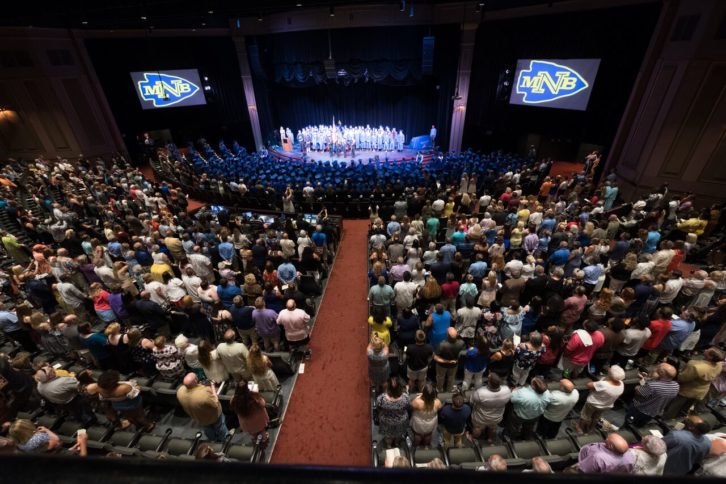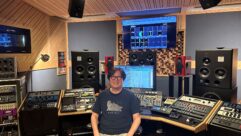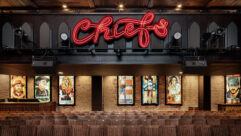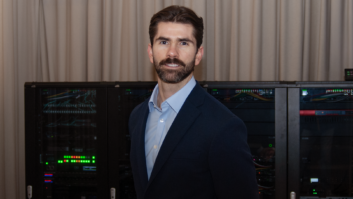
As tourists head into Myrtle Beach, they can’t miss the grand columns and sparkling cupola of the majestic Carolina Opry that can be seen from every direction. A majestic palace, the Carolina Opry stands as a showplace on the Grand Strand Carolina beach stretch. It’s been voted as South Carolina’s “Most Outstanding Attraction,” and the only show to win the coveted Governor’s Cup, the state’s highest tourism award.
The beginnings date back to 1986, when a young country music singer/songwriter migrated from Nashville to bring a new sound to the beachfront when Calvin Gilmore opened a modest 1,000-seat theater in Surfside Beach. Soon, the shows were constantly selling out. So he started a second show in North Myrtle Beach. Those sold out, too.
Forward to 1993, Gilmore merged the two shows into one when he built the 2,200-seat Carolina Opry.
Three sets of stately double doors lead you into grand lobby with 40-foot ceiling featuring custom inset detailing and crystal chandeliers. There’s a grand piano, a historical memorabilia gallery, with twin staircases curving upward to the balcony.
As the facility headed into its 25 year of operation, with as many as a dozen shows a week throughout the year, Opry audio manager Mike Cook had been talking with the owners about the need for a new sound system. The existing system dated back to when it first opened. “It was a point source system that was originally designed for coliseum sound and was probably the right solution at the time,” says Cook. Over the years, “as the room has gone through some seating design changes, we recognized there were coverage holes. Plus the system was showing its age.”
As with any venue, ownership questioned the value of a new system. “If I put in a new sound system, will it put more people in the seats?” Cook’s answer, “probably not, but it will give our customers a better experience.” Those memories will bring people back.
In consideration of a new system, Cook noted the number one issue they are concerned about is vocal clarity as most shows are family oriented musical theater catering to an older audience. “At the same time, we
needed to have the necessary output as we run the shows at 96-98 dB, with select shows such as Time Warp over 100 dB.”
Having owned a sound company, Cook was familiar with RCF. “I owned a HDL20 rig, and I would have to bring it in when we were doing national acts such as Kansas, Bill Gaither, America and others.” Those shows required more energy than the family oriented theatrical productions the Opry puts on.
Once RCF introduced the HDL30 line array system, “it was a no brainer,” comments Cook. “With the RDNet control (RCF’s proprietary monitoring and control software), it gave me the capability of running the system from the booth with the ability to grab and do what we want on the fly as needed.” And as the venue runs a variety of productions ranging from the magic and illusion show Pure Magic to the dance and laser Thunder & Lightning to the contemporary Time Warp, Cook has been able to preset performance needs and handle any situation during live shows.
“We had planned on installing the system after the first of the year when we were in between productions. Suddenly, two to three weeks into our Christmas show when we are doing a 12-13 shows a week, ownership wanted the new system installed.
“I told them I need a week to properly wire, install and tune. We didn’t have that time.” Still, “We did the pre-wire during the week.” Thankfully, “because of the ease of the RCF rigging and hardware, we had the system up in half a day on Sunday producing sound. It was amazing how quick it went up.”
The system is comprised of left and right line array hangs of eight RCF HDL30-A (dual 10” two-way active line array cabinets) with a center cluster of four cabinets used for front fill and adds the needed energy to fill the fan-shaped room, with six RCF SUB9006-AS (dual 18” active subwoofers).
Cook goes on to complement the support from RCF. “RCF personnel came down to help commission the system and trained us on RDNet, showing us some of the ins-and-outs to make our life easier.”
With the new system, “the definition of the instruments and the vocals is impressive,” says Cook. As for ownership, the response was the system is almost too good. “It might be too clean…I can hear the mistakes,” was the comment, going on to finish, “that’s a hell of a PA. That’s what I wanted.”










